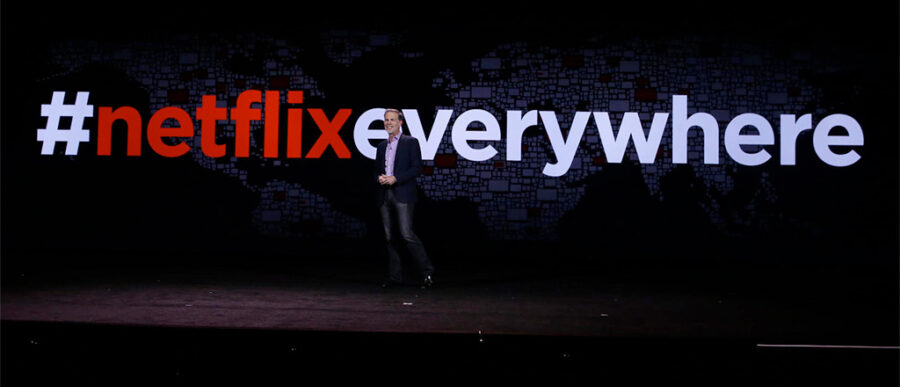On January 6, Netflix co-founder and CEO Reed Hastings unveiled his campaign to conquer the world. At the 2016 Consumer Electronics Show in Las Vegas, the on-demand Internet streaming media provider added 130 countries to the list of 60 where its services are already available. “Today, you are witnessing the birth of a new global Internet TV network,” said Hastings.
There were no cheers from China, which has been left out of the Netflix plan (along with North Korea, Syria and Crimea). There was some dismay in India, where Netflix is initially offering only around 7% of its U.S. library and limited local content. China and India are potentially two of the largest markets for Netflix. India’s mobile subscriber base crossed one billion in October, making it the second country after China to reach that landmark. The younger generation is comfortable watching movies and TV shows on smartphones. India is expected to record 500 million Internet users by the end of 2016, 60% of them accessing the web on mobile phones. China is the clear leader here with 668 million Internet users.
So is Netflix wrong in treating India on a par with Anguilla and Aruba? Kartik Hosanagar, Wharton professor of operations, information and decisions, says there is something to be said for a slow-and-steady approach in a market like India. “Netflix probably acknowledges that the Indian market has to be built up slowly rather than in a big-bang fashion,” he notes.
“We have launched in new countries by region or individually in the past,” says U.S.-based Anne Marie Squeo, director of corporate communications at Netflix. “We’ve learned a lot from those launches and will learn a lot from this one as well. Given the consumer demand for great content delivered over the Internet, we wanted to start meeting that need now rather than waiting.”
Not a Game-changer
Hosanagar doesn’t think Netflix will be a game-changer in India anytime soon. “In the short term, it won’t disrupt the market,” he says. “Netflix has to solve a number of issues tied to infrastructure. That said, the long-term indicators are that it will have a huge impact on the market. YouTube is already big in India, albeit for short-form content. Netflix will need to adapt. A technology solution made for the U.S. won’t work in India. But once it is adapted, I think it can have a great impact on content production and consumption patterns.”
“I think India is a large and important market for most content and distribution platforms, including Netflix,” adds Jehil Thakkar, head of media practice at KPMG India. “Given the nuances of the market, a softer launch will help in terms of learning lessons, evolving practices, building relationships and understanding consumer behavior before a larger and higher profile rollout is made. China continues to be a controlled Internet and content market that does not allow free competition or entry in the media space and this, in fact, heightens India’s importance in the media and entertainment space for the long term…. [Today] Netflix is not necessarily a strong brand in India. Its entry will not have a significant effect — at least in the short term.”
“It is too early to even think of disruption,” says Smita Jha, leader-entertainment & media practice, PwC India. “The Indian consumer base is very diverse.” But, she notes, “the launch of Netflix in India has opened up the debate on OTT [over-the-top content, which refers to audio, video or other media delivered over the Internet without users needing a cable or satellite subscription] in a more serious manner in India. Prior launches by some local players did not create such an impact.” Gurpreet Singh Bhasin, co-founder and COO at One Digital Entertainment, expects that Netflix’s entry will “ensure that domestic players and media giants get more serious about the business and invest for a long-term play.” However, Rajiv Vaidya, CEO of local player Spuul says: “We don’t think Netflix will disrupt the space; it is still a U.S. product, which doesn’t take into account the complexities of India.”
“Netflix probably acknowledges that the Indian market has to be built up slowly rather than in a big-bang fashion.”–Kartik Hosanagar
The likes of Spuul, BigFlix and Hooq were expecting Netflix to enter the market later this year, says Gaurav Gandhi, COO of the newly-formed Viacom18 Digital Ventures, another Netflix competitor. “Naturally, everyone is evaluating the entry strategy.”
A Costly Proposition
According to Gandhi and other experts, some key factors need to be considered when examining Netflix’s strategy for India:
Price: The U.S. cable TV average revenue per user (ARPU) is around $80-$100 while Netflix’s subscription rates are $8-$10. But the Indian cable TV market has one of the lowest ARPUs in the world at $4-$5. At current pricing, Netflix’s basic subscription plan is virtually double.
Data costs: Telecom data costs are very high. In fact, some telecom firms are mulling a model in which voice calls are free. Data is used to balance the books. Prices for voice calls are very low: Tata Docomo, for instance, has unlimited voice plans (free calls during the period of the scheme) which start at less than $3.
The delivery mechanism: “Globally, Netflix consumption is higher via fixed broadband lines [and larger screen viewing at home]. In India, it is primarily on the mobile. In fact, the entire digital boom is mobile-driven,” says Gandhi. This means even higher data costs.
Content: “Netflix will need to grapple with its strategy — whether to be a mass or niche player,” says Jha. “If it is the former, the challenge will be to include [a large amount of] local content so as to effectively compete with the Indian TV broadcast and film fraternity; if the strategy is to go mass, pricing plans may also need to be reviewed as they are currently higher when compared to the average television subscription or film ticket.” Currently, Netflix is offering three plans for India. The basic plan allows users to watch on one screen and costs Rs. 500 ($7.40 at the current exchange rate of $1 = Rs. 67.59) per month. The standard plan (two screens at the same time) is Rs. 650 and the premium plan (four screens) is Rs. 800.
U.S. companies in this space have earlier found they cannot take Western pricing models and extrapolate them to India. Facebook’s second-largest market is India with 125 million users. Out of them, 114 million are mobile users. In the year ended March 31, 2015, the social media giant saw its India revenues jump 27% to $18.26 million and net income rose 33% to $2.4 million. However, revenue per user was 15 cents compared to $10 in the U.S.
If Netflix decides to cut rates, some local rivals may meet it head on. Viacom18 can pick up the gauntlet if it needs a deep-pocket response; the company is owned by the wealthiest Indian, Mukesh Ambani. Hotstar is part of Rupert Murdoch’s far-flung empire. Besides, Hotstar is free. It offers a mix of cricket and local content.
Cricket and Cinema
“India loves cricket and cinema,” says S. Sadagopan, founder-director of the International Institute of Information Technology, Bangalore. “Netflix has the potential to disrupt, provided it is able to source Indian content, price it right and manage the speed of delivery. A small number would love the Netflix U.S. content, but the real disruption will need ‘Made in India, Made for India’ content.”
“We are producing local TV shows in Italy, Brazil, the U.K. and a number of other countries, and expect that list to grow globally along with our service,” says Squeo, the Netflix spokesperson. “In 2016, we plan to spend about $5 billion on programming rights, including many titles that will be exclusive to Netflix around the world. However, content licensing has traditionally been very fragmented and regionalized. It will take some time, several years at least, to get to an offering that is the same everywhere.”
Content matters, experts note. It dictates strategy, pricing and positioning. Local content will have a market in rural areas. But affordability remains an issue and will require out-of-the-box thinking.
In addition, there are other basic hurdles to cope with. One major issue is bandwidth. “The biggest challenge is bandwidth availability,” says Sadagopan. “Hopefully … enough bandwidth will be available soon.” Adds Mohit Jain, research analyst-technology at securities firm Anand Rathi: “Expensive and inconsistent Internet speeds are the biggest challenge for Netflix in India.”
“Netflix has the potential to disrupt, provided it is able to source Indian content, price it right and manage the speed of delivery.”–S. Sadagopan
“I suspect the low-key entry reflects the fact that India’s broadband penetration is low,” says Hosanagar. “Even where a household has broadband, speeds are not true broadband. Netflix will need to make the same kinds of investments in infrastructure in India as it has made in the West. This will include investing in content delivery networks so that its content is stored as close to the end-user as possible. It will need to invest in some additional infrastructure in India to adapt to the mobile. It will need to partner heavily with telecom operators in India. With all of that, Netflix will have a fair shot.” Reliance Jio will be launching 4G services in the country soon (it is in beta now). So, the Netflix launch may be anticipating that.
Squeo of Netflix has an answer to the infrastructure issue. “Netflix automatically adapts the data rate of the video stream to meet the bandwidth available to the member at any point in time,” she says. “Our adaptive streaming engine allows us to automatically adjust the bit-rate of the video stream based on a member’s bandwidth so we can eliminate buffering. We do this by encoding video content for a multitude of devices and formats so we can deliver the one that will provide the best viewing experience.”
There could be other hiccups. Censorship, for one. “The latest James Bond installment has had its license to thrill revoked after [Indian] certification board orders scenes with kissing to be cut by 50%,” said a recent report in U.K. newspaper The Guardian. House of Cards and other programs available on Netflix may face backlash due to the use of four-letter words and other racier content. Then there is piracy; in India, sharing and downloading of copyrighted material is rampant. And credit card frauds have spread to the extent that people are wary of giving information online. Netflix requires card details for even the one-month free trial period, which may prevent many from trying the service.
Is the hurried globalization plan a result of subscriber saturation in its existing markets and shareholder unease as a consequence? Baird Equity Research downgraded Netflix’s stock from “buy” to “neutral” on January 4. “The push toward increased original programming and content costs generally could pressure profitability and cash flow more than expected,” wrote Baird in a note. “…The international markets have lower broadband penetration rates, lower credit usage and lower TV ARPU, all of which could hamper Netflix’s growth in those markets.”
Zacks Investment Research put the Nasdaq-listed stock on its “sell” list. Netflix shares dropped some 7% after the downgrades. However, Netfilx’s stock price doubled in 2015 and the fall may be the result of overly high valuations and investors booking profits.
“It appears Netflix has not done enough homework — the way it is priced initially and the content available at launch time is anything but rich,” says Sadagopan. But Netflix changed the rules of the game and adapted along with its customer base in the U.S. and elsewhere. It is capable of doing so again.



